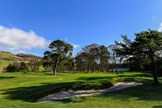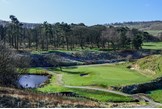The British golf course that inspired Augusta National
Published: Last updated:
Every golfer knows about Augusta National, the most famous course on earth. But few are aware of humble Cavendish in Derbyshire – the course that inspired the Georgia track.
Both were the handiwork of eminent architect Dr Alister MacKenzie and current course designer Jonathan Gaunt has been researching how the game’s most famous course was born – in the Peak District. MacKenzie created Cavendish in 1924, eight years before Augusta National, and though on the face of it the two courses are chalk and cheese, Gaunt has found strong and clear links between the two layouts.
He told TG: “Cavendish had quite a bit of influence on the making of Augusta National. The influence of MacKenzie’s entire body of work inevitably fed into the design of Augusta, but Cavendish particularly has a presence there, with its relatively wide and sloping fairways, carefully and strategicallyplaced bunkers, meandering water hazards and dangerous greens. “Augusta has been developed over the years with many changes and improvements made to accommodate the modern pro and present the course in all its glory to millions on TV.
“However, so much of what golfers love about Augusta can be found at Cavendish, almost untouched for 90 years – and still a challenge. As the younger, glossier, more camera-ready sibling of Cavendish, Augusta’s design ancestry is still clearly visible, affirming that despite all the changes, MacKenzie and his collaborators’ design intentions were good and strong.”
Gaunt now specialises in modernising courses originally designed by MacKenzie, and here he explains why a virtually unknown Derbyshire course was the forerunner to one of the world’s most revered layouts. Of course there is one significant difference between the two courses: you can’t get a game at Augusta National for love nor money while you can play Cavendish for just over £20!
The highs and lows “When first considering the site at Augusta, which at the time was a fruit farm, MacKenzie will have noted the significant elevation changes in the topography, very reminiscent of the site at Cavendish – compare holes one and 10 at Augusta with holes 11 and 16 at Cavendish (both with about 150ft difference in elevation).
The clever layout of Cavendish plays over undulating moorland terrain with deep ravines, valleys, hollows, raised plateaux, incised rivers and challenging side slopes. MacKenzie used the equally dramatic topography at Augusta to his advantage, routing the holes to traverse the contours in a careful and incisive design, to offer a not-too-strenuous yet still challenging game.”

Raised targets
“MacKenzie took advantage of the raised platforms and side slopes on both courses as dramatic green positions. The best examples of this at Augusta are probably the 3rd, 9th and 14th greens. Of the number of raised greens at Cavendish, five and 14 in particular have strong similarities with Augusta’s 9th green with their ‘false fronts,’ designed to repel all but the most perfectly struck shot.”
Sloping greens
“It’s not just all the above that illustrates the relationship – it is also the contouring, for which MacKenzie was renowned. Some of Augusta’sgreens were considered so difficult they were modified by Perry Maxwell later in the 1930s, soon after they were built. Ultimately all the greens at Augusta have been modified since due to the demands of tournament golf, but to get an idea of MacKenzie’s original contouring at Augusta, you really have to go to Cavendish. The contoured greens here are renowned for both their severity and their subtlety. In terms of severity, the slopes and undulations mean they can barely be allowed to read higher than nine on the stimpmeter, especially in summer. However, this is the course’s main defence, as it’s relatively short at under 5,900 yards from the back tees (with only one par 5). Interestingly, Augusta was only 6,300 yards from the back tees when it first opened.”
Strategy required
“On both courses, you have to be highly aware of the placement of the tee shot, and – on the longer holes – of the approach shot, because of the limitations these elements place on their lines of approach. The fairways may be quite wide, but it doesn’t mean golfers can be careless about where to put the ball. Players are frequently enticed into a wrong decision, discovering that some greens just cannot be approached from certain angles. Elements of doubt prevail on every hole.”
Useful bunkering
“No shiny white sand at Cavendish and the bunkers are not large and sprawling, but small and deep (to keep the sand in them on windy days). There are 52 of them compared to Augusta’s 22 – it had even fewer when it opened – but each one has an important purpose and not one is placed purely for ornament. Some bunkers obscure the front third or more of the green, making club selection difficult, and foreshortening views into the green – a trick that MacKenzie drew from his observations on the battlefields of the Boer and First World Wars.”
The setting
“Cavendish was built on open moorland, which is usually quite windswept, playing much like a links course, with pure fescue fairways and slick, bouncy approaches and green surrounds. Today, following extensive planting of native deciduous trees through Forestry Commission grants in the 1990s, the setting of the course has become more parkland in style. This has altered its character over the years, so that it now looks more like an arboretum – a nice echo of the original nature of the fruit nursery site at Augusta National.”


